A Week of Terror in 1968
“We thought the president there was a stooge, an American collaborator. I hated him.”
- Kim Shin-jo, member of a North Korean commando team sent to assassinate the South Korean president in January 1968
On the afternoon of January 17, 1968, a 31-man, hand-picked team of North Korean commandos who had been training together for two years and were experts in knife fighting cut through fencing along the DMZ, crossed the Imjin River, and set up camp on a nearby mountain.
Their mission: infiltrate South Korea’s Blue House (equivalent of the White House) and assassinate South Korean president Park Chung-hee.
Kim Il-sung, the grandfather of North Korea’s current leader, Kim Jong-un, told his men that if all went well the Republic of Korea (ROK) would collapse, resulting in “a glorious revolution” that would see the unification of the Korean peninsula under the Kim regime.
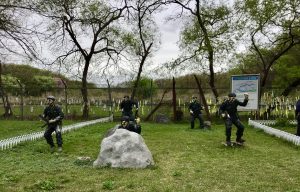
A scenic representation of the commandos crossing the fence at the DMZ at the actual spot where the event took place (PC: Ned Forney).
Two days later the commandos, wearing South Korean uniforms to avoid detection, were spotted by four South Korean brothers. When one of the brothers grew suspicious and asked questions, the four men were immediately surrounded, taken into custody, and threatened with death.
Pretending to go along with a lengthy explanation by the commandos on how their mission would bring a new workers paradise to the people of South Korea, the brothers promised not to tell anyone of the infiltrators’ presence and were released.
As they had planned all along, they immediately reported the incident to the police. The well-trained commandos, however, had slipped into the night. There was no trace of them anywhere.
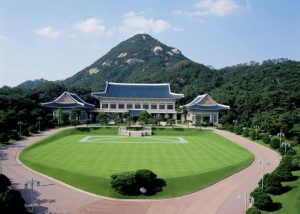
The "Blue House," or Cheong Wa Dae, is the official residence of the president of South Korea (PC: www.visitseoul.net).
Despite increased security in and around Seoul, the commandos made it to within 350 yards of the Blue House before being discovered. In the intense firefight that followed, numerous ROK police and civilians were killed in a flurry of gunfire and exploding grenades. One North Korean commando was captured but immediately committed suicide. The rest of the infiltrators escaped.
Attack on the USS Pueblo
On January 23, as South Korean officials hunted down the remaining commandos, the North Koreans, outraged that the assassination attempt had failed, attacked the US Navy spy ship, USS Pueblo (AGER-2), claiming falsely that it was in North Korean waters. After firing on the ship with 57mm cannons and killing an American sailor, the communists boarded the Pueblo, captured her crew, and then began blindfolding and beating them.
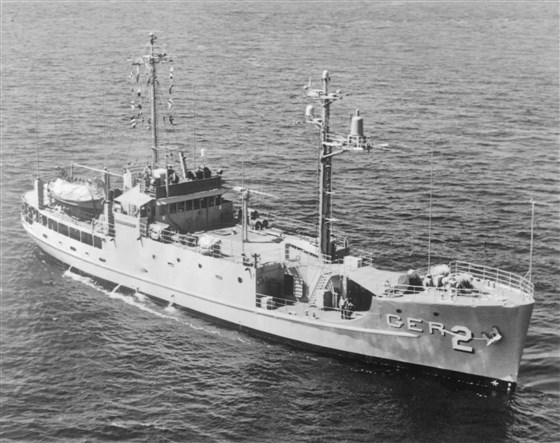
The USS Pueblo on Jan. 23, 1968 (PC: Bettman File)
The 82 captured Americans spent the next 335 days locked in North Korean prisons, where they would endure torture, mock executions, and almost constant interrogations and communist indoctrination lectures.
In Seoul, meanwhile, the manhunt had come to an end. By the last day of January, all but two of the North Korean commandos were dead. One had made it back to North Korea, where he became an immediate national celebrity and later a high-level military leader and politician, and the other was captured.
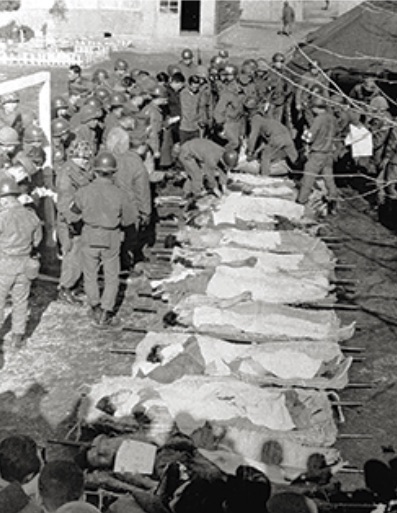
Corpses of North Korean commandos killed during the Blue House raid, Jan. 25, 1968 (PC: National Archives)
"I Tried to Kill the President"
The captured North Korean commando, Kim Shin-jo, was interrogated for more than a year and released when it was discovered that he’d never actually fired a shot or hurt anyone during the assassination attempt.
In an extraordinary twist of fate, he became a South Korean citizen, married, and had two children. When his wife, a devout Christian, eventually convinced him to attend church with her, he experienced an overwhelming sense of calm and peace and became a Christian.
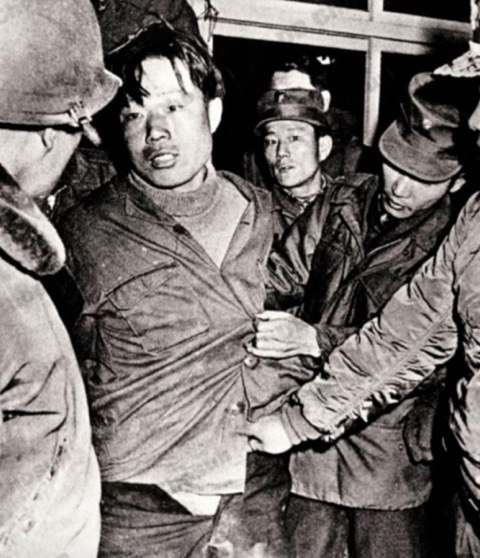
Kim Shin-jo at a police station in Seoul after being captured, Jan. 22, 1968 (PC: AP)
"I tried to kill the president,” he later told CNN. “I was the enemy. But the South Korean people showed me sympathy and forgiveness. I was touched and moved."
Kim’s family, however, was not shown the same mercy by his former countrymen. Several years after the raid, the communists executed his parents and six siblings who were still living in North Korea. “I was deemed a defector, and they executed my family,” he recalled in a 2018 interview with NBC News.
Postscript
Kim Shin-jo became a Presbyterian minister in 1977 and is still alive today.
“I lived, but my heart aches when I think about my parents and my siblings who I left behind," he told NBC. "This is something I have to carry with me to my grave.”
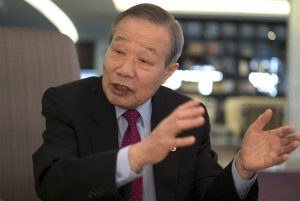
Kim Shin-jo in an interview with NBC in 2018 (PC: Mac William Bishop, NBC News)
President Park Chung-hee, whose wife was inadvertently killed in an assassination attempt on him in 1974, was assassinated by the head of the Korean Central Intelligence Agency (KCIA) in 1979. His daughter, Park Geun-hye, the 11th president of South Korea, is in jail on corruption charges.
The USS Pueblo remains in North Korean to this day. It is moored on a river in Pyongyang as part of the "Victorious Fatherland Liberation War Museum.” Tens of thousands of school children and adults visit the Pueblo every year to learn about the “evils" committed by the United States.

Released crewmen of the USS Pueblo are escorted by military police upon their arrival at the U.S. Army 121st Evacuation Hospital at Ascom City, South Korea, on Dec. 23, 1968. (PC: AP)
Twenty-six South Koreans and three Americans died during the Blue House Raid. The US soldiers, Sgt. Paul Martin, Pvt. Salvador Mojica and the third (whose name the author wasn’t able to find), were killed in firefights with the commandos attempting to cross the DMZ and return to North Korea.
Since the signing of the Korean War armistice in 1953, approximately 90 Americans and 40 South Korean KATUSA soldiers have been killed on active duty in Korea, many on the DMZ. They are memorialized on a monument that was erected at Yongsan Garrison in Seoul in 2012.
Lest we forget.
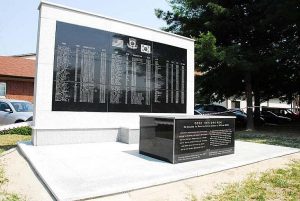
This monument was erected in 2012 in Korea in honor of the 130 American and KATUSA (Korean Augmentees to the US Army) servicemen who have been killed in active combat in Korea since the Korean War armistice was signed in 1953 (PC: Ashley Rowland, Stars and Stripes, June 2012).
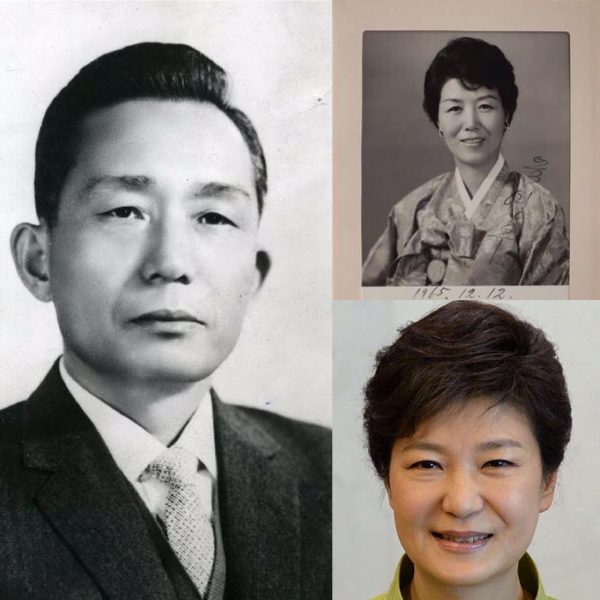
Park Chung-hee (left), his wife Yuk Young-soo (top right), and daughter Park Guen-hye (bottom right) (PC: public domain)
Top/Feature photo: US Soldiers patrol the Korean DMZ, November 1969 (PC: AP)
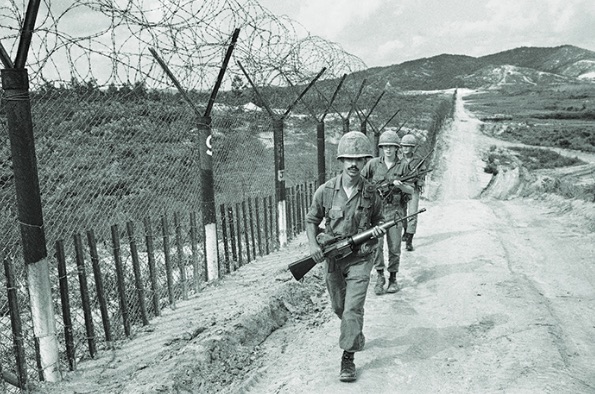
[…] such flashpoints was a series of border clashes and infiltration operations by saboteurs from both North and South which is known as Korean DMZ Conflict or Second Korean War that started in 1966 until […]
[…] such flashpoints was a series of border clashes and infiltration operations by saboteurs from both North and South which is known as Korean DMZ Conflict or Second Korean War that started in 1966 until […]
I had pulled guard duty as a punishment for staying in the ville too long, and a article 15. It was up on a hill called MSA, maximum security area where I think missiles were kept. It was a very cold January 68 and we were all outdoors, and we had been told to be very aware that a team of N.Koreans were trying to infiltrate. They evidently had been seen in the valley just below us outside of Pob Wonni. I heard some shots fired just down range, I think some had been spotted. Fast forward to Dec. 69 and I was a patient at the 121st Evac. Hosp. when the Pueblo crew was brought there. I watched as the copters landed and at one point removed the casket of trooper Hodges. My point is that even though he was killed I very seldom see his actual name mentioned. I took a few pics of the copters up on the pad, but God knows where they are. Thanks to all who served.
What a story, Stephen! I salute you for your service on the DMZ- tough duty!
You’re right about Petty Officer Hodges. His name is rarely mentioned, which is a shame. I’d like to write a story honoring him at some point.
Appreciate your reading this blog and sharing your experiences and insight.
Great write up Kacin. I too was out there on that ill-fated OP1 and the graveyard (OP2). I still have nightmares about that place. Everything was so hush-hush about those infiltrators and those old weapons issued to us. I hated that unit, as I pulled more guard duty than most until Lt. Dewey made me the Messenger/Mailman/company gym attendant after Ron Sargent was busted. Kacin, Magine, and Franklin what a crew! Hope you guys are keeping in touch. Terry Turner and spent many chilling nights guarding Camp McNair.
Thanks for your service as a Korea Defense veteran, Morris. Tough duty on the DMZ, for sure!
Appreciate your reading the blog & comments and responding.
I was a young PFC when this all occurred, serving with ASA @ HQ, Arlington Hall Station, VA. Lived there with my wife and one month old son, worrying about what would happen and would I be shipped outScary days!
Mike- Thanks for reading this post and taking the time to share your perspective. It’s been interesting and informative hearing from people who were in the States and in Korea during that period.
I salute you for your service!
I served on the DMZ from Nov. 68 to Dec 69. I wasn’t there when the Assassination attempt occurred and the SS Pueblo was captured. I was there when the Pueblo crew was released just a couple miles down the road from Camp Dodge, which was the first camp north of Freedom Bridge. I did stakeout (eyes and ears along the Barrier Fence) the night before and we knew the day before the crew would be bused to the Bridge of No Return to be repatriated. I had the day off since I was in the “Fence” all night in a state of alert. I was hoping to get a glimpse of their repatriation, but that was not going to happen if a GI was not ordered there, then there would no chance of that. We knew when all the crew was on the south side of the DMZ though. Word traveled fast. All I saw were the 2 buses carrying reporters and dignitaries that went by our camp heading south. Can’t find the pictures I took of them.
It’s always great hearing your stories, Doug. Amazing to think that you were there! Would love to see those pictures so let us know when they turn up.
I salute you for your service on the Korean DMZ. It’s such an important job, as we know.
What can you expect from N. Korea when they continue to act hostile but our government keeps sending them our money to behave? Have they ever kept a promise made? NO! I am so glad that President Trump isn’t playing with the N. Koreans.
We know we can never trust the North Koreans.
Thanks for reading the blog and commenting, James.